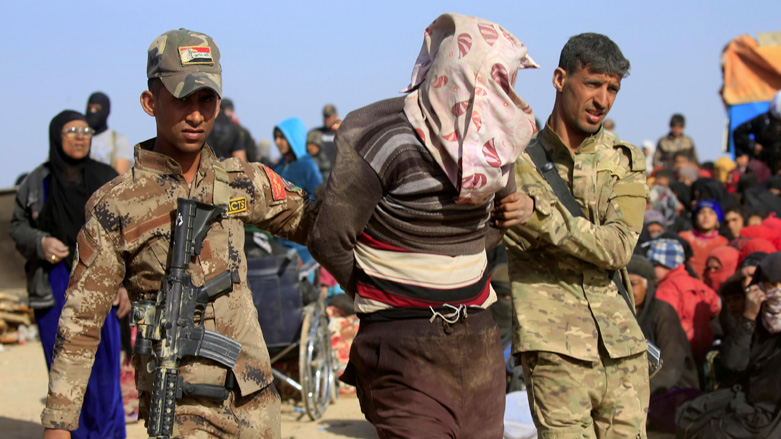Coalition stats show ISIS reemerging in Iraq, but defeated (for now) in Syria

WASHINGTON DC (Kurdistan 24) – A recent report on military strikes released by the US-led Coalition against the Islamic State provides clear evidence of the re-emergence of the terrorist organization in Iraq, even as it is defeated, at least temporarily, in Syria.
In the two weeks from April 7 to April 20, according to the Coalition, formally known as Combined Joint Task Force-Operation Iraqi Resolve (CJTF-OIR), there were “18 strikes, consisting of 36 engagements” against Islamic State targets in Iraq.
CJTF-OIR defines a strike as “one or more kinetic engagements that occur in roughly the same geographic location to produce a single, sometimes cumulative effect in that location,” as explained to Kurdistan 24.
Thus, in that two week period, CJTF-OIR conducted slightly more than one strike a day, with each strike, entailing, on average, two engagements.
By contrast, CJTF-OIR conducted no strikes in Syria over the same period.
The statistics tell the story: the Islamic State has been beaten in Syria—at least for now, but it is coming back in Iraq, despite former Iraqi Prime Minister Haider al-Abadi’s declaration of victory in late 2017 and a similar declaration by US president Donald Trump a year later, regarding Syria.
Trump is the third US president to declare triumph in America’s so-called war on terror—which has gone on, in one fashion or another, since September 2001. Eighteen years is a long time, and that history suggests both the frustrating nature of the conflict, as well as the need for caution in assuming that, this time, the enemy is really defeated.
Indeed, earlier this week, Amb. William Roebuck, Deputy Special Envoy to the Coalition to Defeat ISIS, met with the Chancellor of the Kurdistan Region Security Council (KRSC), Masrour Barzani, who warned of the Islamic State’s increasing attacks in Anbar Province, as well as Mosul, Diyala, and Kirkuk Provinces.
Read More: Kurdish security chief, US diplomat discuss anti-ISIS campaign
“Taking away territory from ISIS was central to the war,” Barzani earlier explained, but “the underlying political and economic conditions remain unresolved.”
In other words, the fundamental problem is political. Sunni Arabs do not feel their needs are addressed by the Baghdad government, nor that it represents their interests. So they have repeatedly embraced terrorist organizations, like the Islamic State, and before that, al Qaida in Iraq.
Such groups are eventually defeated—the US has done it twice now. But the terrorists return, because, as the Kurdistan Region’s Security Chief explained, the underlying problems remain unresolved.
Or, as Masoud Barzani, head of the Kurdistan Democratic Party and former President of the Kurdistan Region, put it, when problems arise In Iraq, "their results are dealt with, rather than their causes.”
Read More: Masoud Barzani critiques Iraq's post-ISIS reconstruction planning in Mosul
“Sleeper cells” are the basic factor behind the resurgence of the Islamic State. On March 23, CJTF-OIR, and its main partner in Syria, the Kurdish-led Syrian Democratic Forces (SDF), announced the territorial defeat of the terrorist organization in that country. However, the SDF has also cautioned about the danger of its reemergence in Syria.
“We had a victory and defeated ISIS,” Mustafa Bali, head of the SDF’s media center, told Kurdistan 24. “But we are now in a new phase,” he continued. “We have to be more capable and organized to track the sleeper cells.”
“Daily, ISIS is making suicide bombs, carrying out assassinations, and destabilizing liberated areas,” he warned. “They themselves made it clear they will start a new phase.”
Who are the people who constitute the sleeper cells? They are locals. The majority of Islamic State fighters in Iraq and Syria are, in fact, Iraqis and Syrians—not religious fanatics from other countries, contrary to the stereotype held by many Westerners.
Najmaldin Karim, Governor of Kirkuk Province from 2011 to 2017—throughout the entirety of the formal fight against the Islamic State—explained to Kurdistan 24 that the terrorist organization in Kirkuk consisted of local people.
Read more: Najmaldin Karim: Islamic State is resurgent, dominated by locals
Using Hawija as an example, Karim explained, “What was called the liberation of Hawija, was basically these people shaved, threw the dishdasha, threw their things, went to their homes, and now they’re being reactivated and are active again.”
Similarly, Aziz Ahmad, an assistant to Chancellor Barzani on the KRSC, described earlier this year, in The New York Review of Books, the Islamic State’s resurgence, observing, “The sense of grievance that fired it in the first place” among Sunni Arabs “remains just as palpable—and just as unresolved.”
Yet Americans are so fascinated—and repulsed—by the likes of Abu Bakr al-Baghdadi, or Osama bin Ladin, or Abu Musab al-Zarqawi, they often seem incapable of seeing anything else beyond religious fanaticism in these terrorist groups.
The Washington Post recently published statistics about an SDF facility that holds women and children associated with the Islamic State: the al-Hol camp. The figures are valid as of April 1 and come from the Autonomous Administration of North and East Syria and the UN Office for the Coordination of Humanitarian Affairs.
The overwhelming majority of the individuals in al-Hol camp are Syrian—43 percent—and Iraqi—42 percent. The remaining 15 percent come from elsewhere, even as they represent the most religiously extreme elements in the facility.
Thinking of the enemy as a bunch of fanatics may be satisfying to Americans and other Westerners. After all, aren’t we so much better than they? Superior to them? But it is misleading, and it may, in fact, help explain, why eighteen years on, we have been unable to defeat this enemy and still must risk blood and treasure in the effort.
(Wladimir van Wilgenburg contributed to this report)
